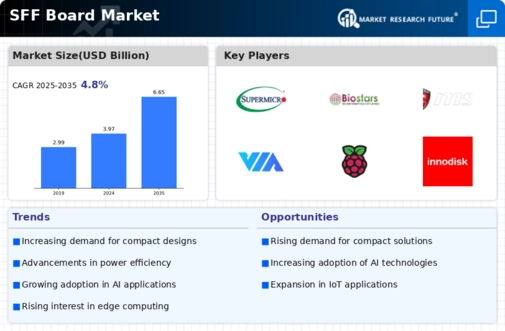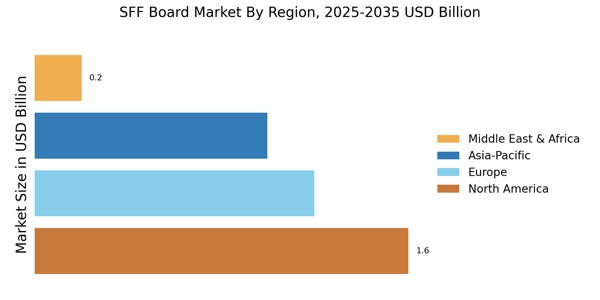Rising Demand in Niche Applications
The SFF Board Market is witnessing a rising demand for specialized applications, which serves as a crucial driver for market growth. Niche sectors such as medical devices, industrial automation, and aerospace are increasingly adopting SFF boards due to their compact size and high performance. These applications often require tailored solutions that can meet specific regulatory and operational standards. For instance, in the medical field, SFF boards are utilized in diagnostic equipment and portable health monitoring devices, where space and reliability are paramount. Market Research Future suggests that the niche application segment is expected to grow at a rate of 9% annually, as industries recognize the advantages of integrating SFF boards into their systems. This trend highlights the versatility of SFF boards and their potential to cater to diverse market needs.
Integration with Emerging Technologies
The integration of emerging technologies is a significant driver in the SFF Board Market, as advancements in fields such as artificial intelligence, machine learning, and 5G connectivity create new opportunities for SFF boards. These technologies require high-performance computing capabilities in compact designs, which SFF boards are well-suited to provide. The demand for smart devices and automation solutions is on the rise, leading to an increased need for SFF boards that can support complex applications. For instance, the implementation of 5G technology necessitates the development of SFF boards that can handle higher data rates and lower latency. Market analysts indicate that the adoption of SFF boards in sectors like telecommunications and automotive is likely to grow significantly, with projections estimating a market expansion of around 12% over the next few years, driven by these technological advancements.
Cost Efficiency and Competitive Pricing
Cost efficiency remains a vital driver in the SFF Board Market, as manufacturers strive to produce high-quality products at competitive prices. The pressure to reduce costs while maintaining performance standards is a common challenge faced by industry players. This has led to innovations in manufacturing processes and supply chain management, enabling companies to optimize production costs. Additionally, the increasing competition among manufacturers has resulted in price wars, further driving down costs for consumers. Market data indicates that the average selling price of SFF boards has decreased by approximately 5% over the past year, making them more accessible to a broader range of customers. This trend towards cost efficiency not only benefits consumers but also encourages innovation within the industry, as companies seek to differentiate themselves through value-added features and enhanced performance.
Sustainability and Eco-Friendly Practices
Sustainability has emerged as a critical driver in the SFF Board Market, as manufacturers increasingly prioritize eco-friendly practices in their production processes. The growing awareness of environmental issues has led to a demand for products that minimize ecological impact. Companies are adopting sustainable materials and energy-efficient manufacturing techniques to align with consumer preferences for greener products. This shift is reflected in the rising popularity of recyclable and biodegradable materials in the production of SFF boards. Furthermore, regulatory pressures are pushing manufacturers to comply with environmental standards, which is likely to shape the future of the industry. Market data suggests that the eco-friendly segment of the SFF Board Market is expected to witness a growth rate of approximately 10% annually, as consumers and businesses alike seek to reduce their carbon footprint and support sustainable practices.
Miniaturization and Performance Enhancement
The SFF Board Market is currently experiencing a trend towards miniaturization, which is driven by the increasing demand for compact and efficient electronic devices. As technology advances, manufacturers are focusing on creating smaller form factors without compromising performance. This trend is evident in sectors such as consumer electronics, where devices are becoming increasingly portable. The SFF boards are designed to accommodate high-performance components in a limited space, which is crucial for applications in IoT and edge computing. According to recent data, the demand for SFF boards is projected to grow at a CAGR of 8% over the next five years, indicating a robust market response to these evolving consumer needs. This shift towards miniaturization not only enhances device functionality but also contributes to energy efficiency, making it a pivotal driver in the SFF Board Market.

















Leave a Comment